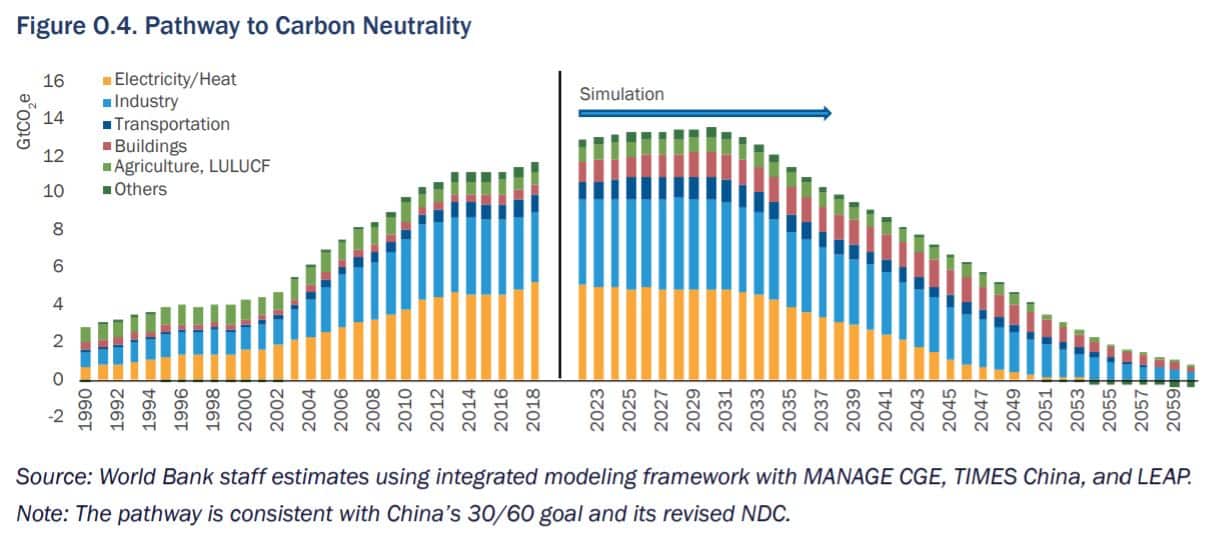China needs US$17 trillion in investments to meet its net zero targets and transition to a low-carbon economy, according to a World Bank Group report.
The effects of climate change are threatening China’s densely populated and economically critical low-lying coastal cities. The country is experiencing coastal erosion, saltwater intrusion, storm surges, and coastal flooding.
Without abating those impacts, the World Bank report said that China may experience GDP losses of 0.5% – 2.3% as early as 2030.
The report entitled “Country Climate and Development Report” (CCDR) for China details the essential changes across sectors needed by the country to achieve its national commitments and reach net zero emissions by 2060.
It emphasizes the urgency of the matter for three reasons:
- China’s massive greenhouse gas emissions
- Heavy exposure of China’s population and economic infrastructure to climate risks
- China’s crucial role in global efforts to fight climate change
Why China Has to Transition to a Low Carbon Economy
China is responsible for a third of the world’s GHG and 27% of global CO2.
Achieving its global climate goals will not be possible without China transitioning to a low carbon economy. This calls for a tremendous shift in the nation’s resources and technologies that boost energy efficiency and productivity.
But the country’s advanced technological capabilities may unlock new opportunities for development in China’s journey to net zero.
- According to the report, China needs as much as US$17 trillion in investments in the power and transport sectors alone for green infrastructure and technology.
Ruth Horowitz, IFC’s Regional Vice President for Asia and the Pacific noted that:
“Given the immense price tag, public investments won’t be sufficient to meet these needs… so China needs policy and regulatory reforms to spur the private sector and fully tap the potential for investment and innovation.”
Private sector participation is indeed vital to China’s net zero goal. And the CCDR underlines the importance of both the public and private sectors working together to tackle it.
The World Bank also outlines several benefits that will enable the most populous nation to turn the climate debacle into an opportunity. These include:
- Increasing returns on the production and development of low-carbon technologies (e.g. wind and electricity storage);
- A high domestic savings rate and a leadership position in green finance; and
- The ability to create high-skilled jobs in high-productivity industries.
Modeling conducted for the report shows that China’s transition would be challenging. It will need decoupling economic growth and emissions at a faster pace and at a lower income level than in advanced economies.
It will also entail major structural changes in China’s economy. Energy, industrial and transport systems, cities, and land use patterns have to undergo dramatic transformations.
However, long-run economic costs are still manageable.
To this end, the CCDR lays out comprehensive policy recommendations that will help China to transition successfully. The sectors covered include the energy, industry, building, agriculture, transport and other sectors.
Below is how China’s pathway to net zero or carbon neutrality looks like for those sectors as per the report’s simulation.
What World Bank Recommends
1: Accelerate the power sector transition with market reforms and investments in renewables
Under this policy package are a set of climate actions. The most critical action is implementing the scale up of solar and wind power generation capacity to 1,700 GW by 2030.
This requires China to add up to 120 GW of solar and wind capacity every year by 2030. That’s 1.5x the annual average during 2016–20 and 20% more than the capacity in 2021.
This recommendation also calls for enhancing the integration of renewables by investing in energy storage.
2: Decarbonize key energy demand sectors — industry and transport
This involves advancing electrification beyond public transport to include private and commercial vehicles. It also calls for scaling up charging infrastructure through private investments.
Currently, electric vehicles in China take up less than 2% of the total fleet and are concentrated in the largest urban areas. So electrification of all types of vehicles are critical for decarbonizing the transport sector.
CCDR also recommends promoting technology development for alternative low-carbon fuels for harder-to-abate sectors. Potential alternatives are green hydrogen and ammonia though they’re not yet commercially viable.
To decarbonize the industry sector, China must place greater attention to circular economy opportunities. They would reduce emissions intensity and help overcome material supply bottlenecks.
3: Enhance climate resilience and low-carbon development in rural landscapes and urban areas
Cities in China play an important role in realizing net zero and development goals. Creating conditions for denser, well-connected, and people-oriented cities is good for the climate.
Also, urban nature-based solutions (NbS) can enhance climate resilience while making cities more livable. Examples of NbS are harnessing wind cooling to deal with urban heat traps and creating integrated green urban spaces to preserve biodiversity.
Estimates suggest the potential to remove at least 768 Mt of CO2e each year by 2030 through NbS in China.
4: Harness markets to drive cost-effective economy-wide abatement and innovation
This policy recommendation suggests expanding the role of carbon pricing.
- Simulations show that a higher carbon price rising to US$50–75 per ton of carbon by 2030 can help reduce China’s emissions by about 15% – 20%.
To get there, China must strengthen its Emissions Trading System design with pre-announced annual emissions cap reductions. This will allow investors to factor future carbon price increases into their investment decisions today.
Expanding the current ETS in the power sector to other high-carbon sectors such as steel, iron, and cement, and gradually transitioning to absolute emissions caps are also important.
5: Manage transition risks to ensure a just transition
Managing risks involves enhancing labor market flexibility and social safety nets. This can also ensure a seamless labor market adjustment in China.
Some actions that can help lower the costs of adjustments are:
- Reducing barriers to labor mobility,
- Reforming the hukou (household registration) system, and
- Ensuring the portability of social benefits
6: Foster global climate action
With China being the largest source of infrastructure financing in low-income economies, adopting climate-friendly investment practices would amplify global impact.
This entails encouraging Chinese lenders (ex. China Development Bank and China Exim) to adopt clean financing principles – “the Equator principles”. They must also phase out financing of coal and other carbon-intensive infrastructure.
Together, these measures form the critical steps that China should take in charting its pathway to net zero emissions by 2060.
But given the uncertainties involved, the policies and their impacts need monitoring and adaptation over time.


